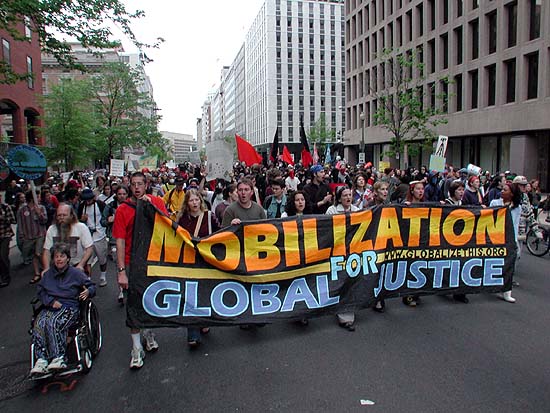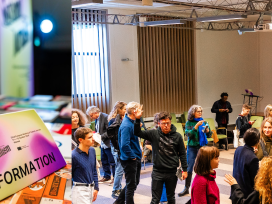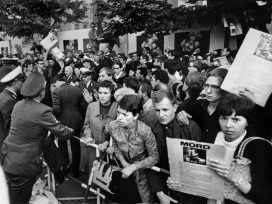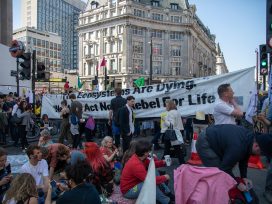What does social movements have to do with democracy? In her article “Activist challenges to deliberative democracy” (published in 2001 in Political Theory, vol. 29, no. 5) the late American political scientist Iris Marion Young explores current views on this issue. On one hand, Young points to a widely prevailing interpretation of social movements as actors who historically have forced their way to significant democratic rights using methods like mass demonstrations, boycotts, sit-ins, and strikes which have subsequently come to be regarded as legitimate. On the other hand, she maintains that methods such as these are sometimes considered “undemocratic” by contemporary opinion, as they are not built on rational arguments aired in open, common-sense dialogue, but are unconventional and confrontational. Social movements are seen alternately as actors creating and extending democracy, and as actors obstructing and destabilizing it. The notion of politics as liberation is confronted by the notion of politics as order.
But in order to understand the full impact of social movements on politics and social developments, we must take both of these aspects into account. Social movements may challenge, change or sustain the institutions and norms of the society of their time. It is on the borderline between ideals of autonomous freedom and the upholding of order that politics is created and social changes are initiated. When the underlying conditions of this tense relationship are renegotiated, social movements often play a prominent role.

Source: Matthewkavanagh/Wikimedia
Historically speaking, disagreements about whether social movements promote democracy or disturb order are nothing new. At times of great social change, both scholars and those in power have sought greater knowledge of growing political actors and emerging forms of political action. This appears to be happening again today, as illustrated by Iris Marion Young’s article. Her starting points are the demonstrations against the World Trade Organization (WTO) by the global justice movement in Seattle in 1999 and the demonstrations at summit meetings the following years. This movement has been variously called the anti-globalization movement, the globalization critical movement, the alter-globalization movement and the globalization movement. As this variety of names indicates, it is linked to one of the greatest transformations in politics and its social preconditions, namely globalization.
It could be claimed that the protests, criticisms and demands of the global justice movement are expressions of a will to renegotiate the different forms of political autonomy. In the closing years of the twentieth century, the movement has emerged in part from criticism of the negative social and political effects of economic globalization, in part from a desire to make the globalization process more socially sustainable and democratic. We are thus talking about criticism not only of the democratic deficit among supranational and global institutions, but also of the market-orientated economic policies with which these institutions have been linked. New communication technology has facilitated the linking up of the various organizations, networks and movements which have this critical stance and certain political goals in common. In this way, the movement has become a rallying point for a multiplicity of actors such as trade unions, environmentalists, church groups, organizations promoting international solidarity, women’s organizations, new organizations such as ATTAC, political parties, and others. The movement’s concrete statements in the public sphere have mainly consisted of mass protests and, since 2001, large alternative conferences, so called social forums. At the global level, the World Social Forum has been held in Porto Alegre, Mumbai, Nairobi and other cities, but many social forums have also been arranged at continental, national and local levels.
Scholars have long associated the concept of a social movement with the notion that social conflicts and injustices or political exclusion often generate a mediating movement, from society to its political institutions. The rise of social movements is generally seen as a reaction to broader social transformations or conflicts – political, economic and cultural. At the same time, such movements have been noted for themselves bringing about social transformations, consisting of new forms of action, norms, and institutions. The labour movement is the most obvious historical example. The attention drawn to the “social question” – i.e. the critique of the misery and inequality which industrial capitalism brought with it, and the resulting demands for social reform and universal suffrage – led to radical changes in society. The welfare state, democratic citizenship, social levelling and structures for dealing with conflicts of interest between labour and capital were all solutions to the “social question”, implemented to varying extents where such institutions were set up. Many of these solutions, often organized by nation states, had their origins in the critique, utopian proposals, and alternative ways of life put forward by social movements. This meant that the movements played an important role in the emergence of the epoch of “organized modernity” that came to dominate the twentieth century.
Closer in time are the “new social movements” of the 1960s and 70s: the peace movement, the civil rights movement in the US, the “new left”, the anti-Vietnam movement, the environmental movement, the feminist movement, and so on. These movements reacted to many of the conflicts, hidden or open, which characterized the welfare society that had been developing in the post-war period. They criticized the system’s hierarchies, privileges and exclusions, and they are generally considered to be more focused on self-fulfilment, cultural identity, and decentralized autonomy than the old social movements were. Rather than taking over and changing state institutions, they sought new opportunities for self-government outside the state. The boundary between the private and the public was called into question, and was expressed for instance as in a central slogan of the feminist movement: “The personal is political”. This drew attention to the role of individual action in reproducing or resisting injustices in society. Everyday relationships, too, were to be democratized. Many of the new social movements highlighted questions of global survival, such as the arms race, environmental pollution, and international inequalities. A number of these critical points did achieve sweeping changes in the political agenda and introduced or revived political questions such as the rights of women, environmental protection, and workplace democracy.
These historic examples can be seen across the board as collective expressions of a will to change the preconditions for society’s autonomy to encourage its evolution in the direction of greater freedom for more people. To talk of social movements thus implies acknowledgment of a central aspect of the democratization or massification of modern society.
An interesting perspective on the societal impact of social movements is offered by sociologist Luc Boltanski in his “The left after May 1968 and the longing for total revolution” (Thesis Eleven, no. 69, 2002). He takes as his starting point the protests of 1968, the criticisms voiced there, and the role these subsequently played in the social changes of the following years. Boltanski believes that these protests were permeated by two kinds of critical stance on society, which he terms “social critique” and “artistic critique”. Boltanski’s view is that these two stances are not at all new, but have characterized the attitude of social protest movements to the shortcomings of prevailing societies, and particularly of capitalism, throughout modernity.
Social critique often highlights questions of inequality, poverty and exploitation, while distrusting the kind of individualism that undermines the solidarity of society and equality between individuals. Boltanski sees the labour movement as a classic representative of this critical stance. Organized modernity should undoubtedly be seen as a response to this type of criticism, as formulated through the “social question”.
Artistic critique, by contrast, had its social basis among intellectuals and artists, who believed that capitalism and industrialization reduced individuals to one-dimensional beings. This critical stance was instead based on opposition to oppression (for example to the discipline of factory life, or the dominance of market forces), the standardization of mass society, and the tendency for more and more social relations to become commercial commodities. Its ideal was instead liberation and individual autonomy, as understood from an underlying belief in what is unique and authentic.
According to Boltanski, both these critical stances were central to the protests in the wave of radicalization of the 1960s, but the social changes that ensued were more in line with the artistic critique and implemented at the expense of the social critique. The restructuring of working life towards autonomous teams, flexible working hours, and performance based salaries were a response to artistic critique and led to a transformation of working life. At the same time, those institutions that had been created to disarm social critique were weakened. Income inequality increased, but were accepted because of a widespread perception that the old hierarchies and chains of command had gone from the new forms of working life that were emerging. Social critique, on the other hand, was even harder pressed than before, and over the years that followed its demand for equality was downplayed within the social movements. Boltanski’s study thus sheds light on the double-edged influence of the new social movements on the restructuring of society from organised modernity to the modernity of our time, along with the evolution of these movements themselves during this process.
The global justice movement is perhaps the one that today most obviously attempts to engage with the conflicts around society’s autonomy that have been brought to a head by the great social and political transformations of our time. This movement has certain elements in common with the new social movements, but differs in other respects. Any discussion of how these similarities and differences are to be understood in relation to the great societal changes of recent decades requires us to employ the concepts of globalization, individualization, and civil society, which in recent times have become central to any description of our age.
In discussing globalization, one can firstly point to the way the institutional preconditions of political action have changed in the last twenty to thirty years. This process has in many respects been fuelled by changes within nation states. The result of this development has however been that government of society has to some degree been denationalized and an increasing number of regulatory functions have passed to supranational bodies such as the IMF, EU, WTO, and World Bank. The policies recommended to states by the supranational bodies have led to the privatization or partial privatization of a series of public functions. Within individual nations, the executive power has simultaneously been strengthened at the expense of parliaments while the political parties who are supposed to represent the citizens attract fewer and fewer members and thus lose their ties with the people.
Taken as a whole, this process of change is seen to have signified a weakening of the ties between the citizens and the state, and a blurring of the boundaries between private and public. It has not, as was the case with the social movements, been a matter of politicizing and democratizing the private sphere. On the contrary, the public has been privatized and processes that were earlier public have been withdrawn from public scrutiny and democratic political influence.
The global justice movement can be seen as a political response to this in a double sense. Firstly, the movement exposes the democratic shortcomings of nation states and the democratic deficit in global institutions. Secondly, the movement formulates what can be seen as the social question of our time, namely the growing inequalities arising from the more market-oriented policies of global institutions and nation states. The common good as well as a will to democratize global power is used to stem the wave of privatization.
There is more to globalization, however, than de-politicization, privatization, and the spread of market forces. Alongside these we have seen the emergence of what might be called new forms of citizenship. The global norms that have guided the supranational bodies have created new political opportunities. In parallel with these bodies, new transnational public bodies have been created with the aim of bringing pressure to bear on the denationalized order. The social forums, particularly the World Social Forum, are clear examples. The forums are helping to develop a global grass-roots identity, to formulate political demands for global rights, and to establish a transnational public body for political interaction.
At the same time, the activism of the global justice movement remains strongly linked with local engagement. This indicates that even locally rooted processes can play a decisive role in globalization. But unlike global institutions, for example, such processes do not drive globalization forward at a global level, but rather at lower, geographical levels. Though activism in the global justice movement may be local, it is linked to global networks. Its activism is based on a notion of the global and contributes to the creation of global norms.
In discussing individualization one can secondly point to the way in which the cultural preconditions of political action have changed since the end of the 1960s. Here, the significance of the new social movements for the cultural values central to society today can be clearly seen. The fact that the ethics of loyalty and belonging that characterized much of organized modernity have become less important, while values such as self-fulfilment, authenticity and creativity – often referred to as “post-material values” – have increased in importance, can be ascribed in part to the “artistic critique” voiced during the 1968 protests. The cultural changes that have arisen include the “life politics” approach that has been important to new social movements since the 1960s. Within the framework of this approach, individual action has assumed a central role and politics has been interpreted as extending beyond what happens within the institutions of state and the systems of representative democracy. This criticism has even led political parties to adapt their way of working and made forms of action inspired by life politics, such as consumer boycotts, more common, bearing witness to their successful impact.
The shift in balance between social security and individual autonomy should be regarded as one of the causes of recent years’ globalization protests. As we have seen, these are precisely the issues that have been central to the global justice movement. Yet the movement has combined a revival of “social critique” with a (left) libertarian emphasis on diversity and non-hierarchical, looser forms of organization. The “flexibilization” of the labour market, the increasing number of individual choices in welfare services, the increased personal risk in national insurance systems etc., have led to an increasing individualization of the systems originally created to solve the “social question”. The movement, by contrast, is campaigning for these questions to be handled in common, rather than private, systems (which need not necessarily imply a return to the forms of organized modernity).
This also shows that individualization does not necessarily involve the sort of politicization of everyday life that the new social movements desired. Its advance can equally well involve a de-politicization of everyday life, in the sense that the new ideology of freedom of choice is turned into systems even further removed from political self-government and the individual’s ability to influence them.
The new social movements were critical of the idea of political representation and the division between public and private, as they considered that a state-centred understanding of politics merely concealed the inequalities that existed outside the state and put them beyond reach of change. The activists in the global justice movement have a different critical emphasis. They prefer to defend the public and the political institutions, and other forms of political autonomy that have been undermined by globalization. They express a will to restore a sense of the public in an age that is perceived as far too focused on the private. One could therefore say that while the activists of the global justice movement certainly do exploit the new forms of politics made possible by individualization in the form of life politics, they do so with the aim of politicizing depoliticized, privatized systems and giving them renewed political and public meaning. Broadly speaking, they want to restore and widen the role of the citizen. But the activists’ life politics approach to traditional, organization-bound, belonging-orientated forms of action also indicates their wish to create other kinds of political communities that remain autonomous from the institutions of the state.
Thirdly in the discussion of civil society, one can point to how the social conditions of political action have changed. This has to do with how globalization and individualization have influenced the role of social movements as actors in civil society, and their relationship with political institutions. If the social movements in the period of organized modernity tended to become institutionalized and tied to the state and its political projects, more recent decades have seen greater stress on the movements’ autonomy from the state.
At the global level we can see how social movements in the 1970s and 1980s became central actors in the democratization of former dictatorships, while since the 1990s they have turned their critical attention to the democratic deficit in increasingly powerful global institutions. To be able to make their point in the debate, they have initiated global campaigns and created transnational public bodies with the goal of making the voices of ordinary people from the grass roots level heard, even in a more globalized power structure.
Against this background we can see the importance of both the social forums and internet-based communication and information networks within the global justice movement. The social forums provide a sort of alternative public institution, which can be seen as an emergent social form of common action, dialogue and knowledge creation. The social forums are arenas not just orientated towards a specific political issue or even a specific set of issues, but also aiming to create a new kind of public body. Similarly, the movement has made use of new, digital methods of communication that promote openness and participation on a non-commercial basis.
Where attitudes to democracy are concerned, one can say that the dominant approach in the global justice movement is one of “participatory democracy”. The movement’s activists place little trust in political institutions, but they participate widely in elections and stress the importance of representative political institutions. The activists’ perception is that these institutions have been thrust aside by private systems and have a weaker connection with citizens than before. But the activists simultaneously maintain that parties and institutions must be counterbalanced by the social movements, and without exception express a view of democracy emphasising grass-root engagement. In addition, the activists want to defend what they see as the classic Swedish “tradition of social movement” [folkrörelsetraditionen], that is, a model for self-government that is both movement and institution orientated.
Within the global justice movement, emphasis is also laid on a participatory democratic approach to politics, arising from the institutional changes of globalization and the processes of cultural change that are linked to the individualization of our age. This can be related to our society’s ambivalent understanding of the connection between social movements and democracy. As previously stated, social movements are presented both as actors creating and expanding democracy, and as actors who obstruct and destabilize it.
It is nothing new for political methods such as boycotts and blockades to be seen as “undemocratic”. In spite of widespread acceptance of such an attitude at the time, the perception of the legitimacy of either the actors or the methods often changes with hindsight making it seem strange that they were met with opposition. Editorials of the Swedish social democratic press in 1960, for example, argued that the boycott of South African goods promoted by the Swedish Trade Union Confederation (LO) was not only an ineffective political tool, but also meant that the trade unions were venturing into foreign policy areas where they did not belong. Issues such as this were to be reserved for institutions and politicians negotiating with other states. The general opinion of the political legitimacy of consumer boycotts has obviously entirely changed since, as can be seen from their widespread use not only by movement activists but by large segments of the general population. This shows how the meaning of self-government and democracy in society changes over time, with social movements often playing an active role in that change.
When the political legitimacy of the global justice movement has been questioned, often for its summit meeting protests, it’s due to it being seen as disturbing the discussions of elected delegates and thus sabotaging or obstructing democratically legitimate processes. Iris Marion Young raises the difficulty, for those who perceive democracy as “deliberative”, of understanding the significance of the movement’s activism for democracy when their view of democracy understates the role played by the forms for political dialogue and the social structures underlying it.
If the deliberative democrat claims that the activist is turning his back on democratic discussion, the activist himself can counter that by not participating in such a discussion he avoids legitimizing democratically defective forms of politics. Moreover, the activist could point out that he has not been invited to the summit discussions, that the agenda for discussion has been decided by top politicians and that the discussion is taking place behind closed doors in a format designed to exclude.
A critique of this kind, concentrating on the lack of reflection on the forms and preconditions of political discussion is in Young’s view the essence of the activist perception of democracy. She sees this perception as grounded in the idea that structural inequalities can exist even within a formally democratic system. It is therefore a question of highlighting the social bases of democracy and seeing democracy as an unfinished project.
Seen in this light, democratic politics implies that democracy is something permeating even our everyday lives, so it follows that the extension of democratic forms of government into ever more areas of society is seen as desirable, but at the same time there is an acknowledged need for the creation of underlying social conditions that make it genuinely possible for the majority to participate in politics. The activists of the global justice movement express a perception of democracy that attaches great importance to equality and actual political participation. They believe that the institutions of parliamentary democracy and other forms of politics built on representation are the minimum one can demand of a functioning democracy, but see them as limited and insufficient. For a democracy to be worthy of the name, citizens must also take part in political processes in a range of different ways: through social movement activism, as members of political parties, or in their everyday actions. This also means wanting democracy to spread to more areas of society. The question of how self-governing of our society should be organized is considered permanently open for debate.
The movement’s criticisms, proposals, and debates can be seen as representing one of two democratic models whose mutually tense relationship defines crucial differences in the perception of democracy in our epoch of modernity. On the one hand we have the neo-liberal inspired model of “legal democracy”, that seeks to minimize the influence of social interests on the state, limit the influence of the state and restrict political power to enlightened elites. On the other hand we have the participatory democratic view that is central to the global justice movement. This model aims to make politics more conscious of its social foundations, include more people in politics, and broaden democracy in society. The contest between these two views is basically about how the autonomy of society should be realized during a time when political power is being denationalized and becoming more transnational.









